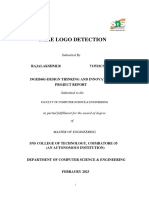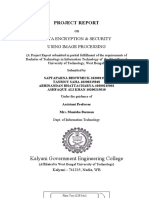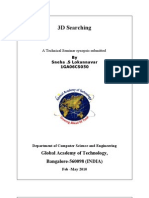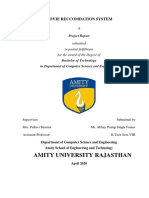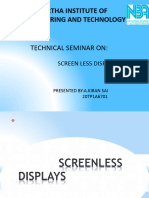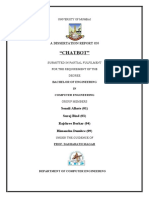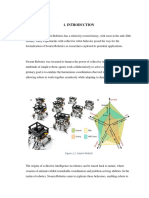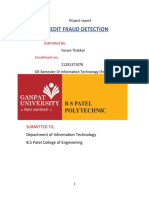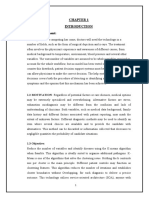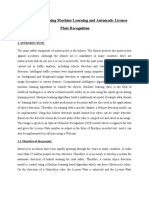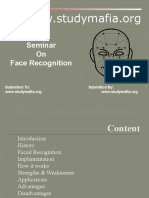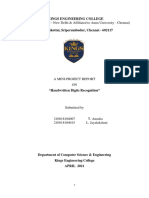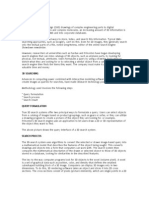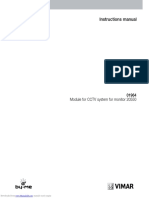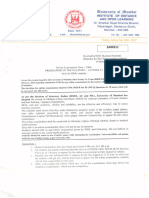3d Searching....
3d Searching....
Uploaded by
Sadik Hussain PCopyright:
Available Formats
3d Searching....
3d Searching....
Uploaded by
Sadik Hussain POriginal Description:
Copyright
Available Formats
Share this document
Did you find this document useful?
Is this content inappropriate?
Copyright:
Available Formats
3d Searching....
3d Searching....
Uploaded by
Sadik Hussain PCopyright:
Available Formats
3D MODEL SEARCH ENGINE
1. INTRODUCTION
Today both the internet and corporate warehouses are full of all types of digital information, from simple text documents to complex application. One type of information gaining in prominence in 3D object. From computer-aided design (CAD) drawings of complex engineering parts to digital representations of proteins and complex molecules, an increasing amount of 3D information is making its way onto the Web and into corporate databases.
Because of this, users need ways to store, index, and search this information. Typical Web-searching approaches, such as Googles, cant do this. Even for 2D images, they generally search only the textual parts of a file, noted Greg Notes, editor of the online Search Engine Showdown newsletter.
However, researchers at universities such as Purdue and Princeton have begun developing search engines that can mine catalogs of 3D objects, such as airplane parts, by looking for physical, not textual, attributes. Users formulate a query by using a drawing application to sketch what they are looking for or by selecting a similar object from a catalog of images. The search engine then finds the items they want.
3D MODEL SEARCH ENGINE
2.BASICS OF INTERNET SEARCHING
Internet searching typically involves placing a keyword in the search box and clicking search. The search engines crawls through the websites and rate a webpage according to the occurrence of the keyword in the page. Some of the internet searching techniques is
Search Engines
The world-wide web is changing the way we nd and use information. It provides access to a vast amount of text and image data on every conceivable topic. Unfortunately, the sheer quantity of information can make it dicult to quickly nd what you are looking for. To aid in this search, many search engines exist that index large portions of the web. They typically provide a search interface based on text keywords: a user enters some descriptive keywords (e.g. Boeing 747), after which web pages containing these keywords are returned. Examples of popular text-based search engines are Google and AltaVista.
However, the web does not just contain text pages, but a lot of non-textual data as well, such as images, sound les, or CAD models. Many so-called specialized search engines targeting these specic kinds of data have been developed. Perhaps the biggest such search engine is Google Image Search, which indexes hundreds of millions of images. Other examples are Find Sounds, a search engine for sound les and Mesh Nose [67], a search engine for 3D models. Many of these specialized search engines take advantage of the fact that even though the indexed objects are of a non-textual type, often they are annotated with descriptive text. The search engine then simply tries to match the userentered keywords to this descriptive text.
3D MODEL SEARCH ENGINE Figure 2.1
3D MODEL SEARCH ENGINE
A 3D Model Search Engine
To improve the accessibility of all these online 3D models, we have created a prototype specialized search engine for 3D models. It supports a text-based query interface and several dierent types of shape-based query interfaces. Figure 2.1 shows a screenshot of the actual search engine web site, with its main components annotated. On the left side of the page the user can enter queries and specify which database is to be searched (both free and commercial databases have been indexed). On the right side search results are shown, as well as links that allow the selection of dierent query interfaces and miscellaneous pages with a feedback form, information about our research, and links to similar projects elsewhere Challenges
The challenges in creating such a search engine are threefold. First, the 3D models available on the web have to be found. Unfortunately, most of the online 3D models are scattered across the web, on repository sites, project sites, and personal homepages. Second, it is not obvious what the best query interface is for searching a database of 3D models. Additionally, an important goal for our search engine is that it is useable by the average user. By average user we mean someone who knows what 3D means, and is able to manipulate a 3D model using a viewing interface, but not necessarily a computer graphics professional. This means that the query interfaces should be intuitive and easy to use. And nally, user-entered queries have to be matched to 3D models. For each type of query a suitable matching method needs to be developed. Also, because the search engine is an interactive system, a matching method has only limited time to run.
3D MODEL SEARCH ENGINE
3.SYSTEM OVERVIEW
Figure 3.1: System organization
The organization of our system is shown in Figure 3.1. Execution proceeds in four steps: crawling, indexing, querying, and matching. The rst two steps are performed offline, while the last two are done for each user query. The following text provides an overview of each step and highlights its main features:
1. Crawling: We build a database of 3D models by crawling the Web. 3D data still represents a very small percentage of the Web, and high quality models represent an equally small percentage of all 3D data. So, we have developed a focused crawler that incorporates a measure of 3D model quality into its page rank. Using this crawler, we have downloaded 17,834 VRML models from the Web. We augment this database with 2,873 commercial models provided by 3D vendors [43, 24].
2. . Indexing: We compute indices to retrieve 3D models efficiently based on text and shape queries. In particular, we have developed a new 3D shape descriptor based on spherical harmonics that is descriptive, concise, efficient to compute, robust to model degeneracies, and invariant to rotations
3D MODEL SEARCH ENGINE 3. Querying: We allow a user to search interactively for 3D models. Our system supports query methods based on text keywords, 2D sketching, 3D sketching, model matching, and iterative renement. We nd that methods based on both text and shape combine to produce better results than either one alone.
4. Matching: For each user query, our web server uses its index to return the sixteen 3D models that best match the query. Our method answers 3D shape queries in less than a quarter of a second for our repository; and, in practice, it scales sub-linearly with the number of indexed models.
3D MODEL SEARCH ENGINE
4.3D SEARCHING
Advances in computing power combined with interactive modeling software, which lets users create images as queries for searches, have made 3Dsearch technology possible. Methodology used involves the following steps
Query formulation Search process Search result
4.1QUERY FORMULATION
True 3D search systems offer two principal ways to formulate a query: Users can select objects from a catalog of images based on product groupings, such as gears or sofas; or they can utilize a drawing program to create a picture of the object they are looking for. or example, Princetons 3D search engine uses an application to let users draw a 2D or 3D representation of the object they want to find.
3D MODEL SEARCH ENGINE
Figure 4.1: The above picture shows the query interface of a 3D search system. left side of the search engine have an option to draw shape based query and keyword query. From above figure user enter a shape based query(car) ,which is the query to be searched. On the right side search results are shown.
4.2 SEARCH PROCESS
The 3D-search system uses algorithms to convert the selected or drawn image-based query into a mathematical model that describes the features of the object being sought. This converts drawings and objects into a form that computers can work with. The search system then compares the mathematical description of the drawn or selected object to those of 3D objects stored in a database, looking for similarities in the described features.
The key to the way computer programs look for 3D objects is the voxel (volume pixel). A voxel is a set of graphical datasuch as position, color, and density that defines the smallest cube shaped building block of a 3D image. Computers can display 3D images only in two dimensions. To do this, 3D rendering software takes an object and 8
3D MODEL SEARCH ENGINE slices it into 2D cross sections. The cross sections consist of pixels (picture elements), which are single points in a 2D image. To render the 3D image on a 2D screen, the computer determines how to display the 2D cross sections stacked on top of each other, using the applicable interpixel and interslice distances to position them properly. The computer interpolates data to fill in interslice gaps and create a solid image. The steps involved in transforming the query to search query are normalization and voxelization. Normalization is the process of transformation of a 3D model into a standardized or canonical form that retains all the relevant geometrical information of the original model. 3D model have arbitrary scales, orientations and position in the 3D space. In many situations. They are required to normalize the size and orientation of 3D model before feature extraction in order to represent. It in a canonical coordinate system. The aim of the normalization is to guarantee that the same feature representation can be properly extracted from the same 3D object with different scale, position and orientation. The canonical coordinate normalization, such as alignment and scaling
Voxelization is the process of converting a representation of a 3D shape into a set of small volume elements (voxels) [1]. The procedure of voxelization is as follows: (1) Bound the model with a bounding box; (2) Divide the bounding box into N3 small boxes (voxels) with equal volume; and (3) Assign one to a voxel if it contains a part of the CAD model, and zero otherwise.
The search system then converts this voxel model into a form consisting of the skeleton of object. This skeleton represents the basic framework of the model. The model is then searched with those in the repository. If match is found then the object is returned
3D MODEL SEARCH ENGINE
4.3 AN EXAMPLE SEARCH SYSTEM: 3DESS
Scientists at the Purdue Research and Education Center for Information Systems in Engineering, led by Professor Karthik Ramani, created a 3D shape search technology called 3DESS (3D Engineering Search System; http:// tools.ecn.purdue.edu/~cise/dess.html).The engine is designed primarily to find computerdesigned industrial parts. 3DESS gives users three options for searching industry databases: using a drawing application to sketch a part from scratch, penciling in modifications to an existing part to create a new search object, or selecting a part from a catalog of choices. 3DESS then develops a skeletal graph, using an algorithm that analyzes and renders the skeleton in terms of three common topological constructs: loops; edges; and nodes, which are connecting points between loops and/or edges. Expressing an object in terms of these common constructs, plotted on a graph, reduces the overall amount of data in the object representation and makes it easier to store and index descriptions in the database. According to Ramani, 3DESS also describes objects in terms of feature vectors, a set of mathematical representations of various aspects of the items shape, such as its volume, surface area, and the number of loops, edges, and nodes. The system can analyze a query by comparing either its feature-vector set compares queries shape representations with those stored in the database to find the ones that are most similar.
10
3D MODEL SEARCH ENGINE
Figure 4.2 Purdue universitys 3DESS search technology start with a) A drawing of an object that a user want to find in a database. The system extract the most important parts of the shape to create. b) A skeletal, a reduced graphical representation of the object.3DESS then develops. Skeletonization is the process of extracting a skeleton from a 3D binary image (voxel model). The model can be converted into a binary 3D digital model. However, in digital spaces, only an approximation to the true skeleton can be extracted. The two requirements for a skeleton are: 1 Topological: A skeleton must retain the topology of the original object. 2 Geometrical: A skeleton must be in the middle of the original object and must be invariant to translation, rotation and scaling.
c) The skeleton is converted into a hierarchical skeletal graph, for storing in database. Skeleton graph in terms of three common topological constructs loop, edges, and nodes. This further reduces the amount of data in the objects representation and make it easier to store, index, and search for descriptions within the database Node the voxel situated at the ends of the edges Edge Set of voxels forming a single geometric entity Loop One or more edges forming a closed entity Each edge in the skeleton translates into an independent geometric entity giving a shape to the model in physical space. Similarly, each loop represents a hole in the 3D model. 11
3D MODEL SEARCH ENGINE For example, if a user wants to search for models with holes, it can be completed by searching for graphs with loops..
When the system retrieves models in response to a query, users can input which models more closely resemble the object theyre seeking. 3DESS then uses neuralnetwork technology to analyze users feedback, learn more about what they want, and fine-tune both the current search and future similar searches.
12
3D MODEL SEARCH ENGINE
5.PRINCETON UNIVERSITY SEARCH SYSTEM
Professor Thomas Funkhouser and his colleagues at the Princeton Shape Retrieval and Analysis Group (www.cs.princeton.edu/gfx/proj/shape) developed their Web-based 3D Model Search Engine. The engine works with a Java-based application that lets users produce, via their mouse, 2D renderings of objects to search for in a database.
The Princeton search engine, like its Purdue counterpart, uses mathematical representations to store the salient characteristics of 3D shapes in its dataedges, and nodes. The system can analyze a query by comparing either its featurevector set potential obstacles. The system compares queries shape representations with those stored in the database to find the ones that are most similar. Princetons 3D search engine first renders a 3D object or drawing as a voxel grid and then maps this to a sphere, yielding spherical-based mathematical functions. The system then breaks the spherical functions into component parts that make up the ultimate shape descriptor, a graph like abstraction that represents the items overall shape.
An advantage of the spherical approach is that it lets the search engine work with shape descriptors regardless of the objects position. Thus, the system will match a query with the appropriate result even if the query drawing is positioned differently than the object in the database. Searchers can refine their queries by adding a text description.
13
3D MODEL SEARCH ENGINE
6.SETUP REQUIRED
On server side it requires a high performance computer for evaluating shape based retrieval and analysis algorithms. For each 3D model, there is an Object File Format (.off) file with the polygonal geometry of the model, an ASCII text file with information about the model (e.g.. the URL from hence it came), and a JPEG image file with a thumbnail view of the model, It contains a large database of 3D polygonal models collected from the World Wide Web. On client side high speed internet connection is required. The site should work with Netscape 4.0 or up, or equivalent with Java and JavaScript enabled. Java version should be 1.2 or above.
14
3D MODEL SEARCH ENGINE
7. TECHNICAL FRAMEWORK
7.1 SHAPE REPRESENTATION
A key issue in developing a shape-based retrieval and analysis system is to find a computational representation of shape (a shape descriptor) for which an index can be built, similarly queries can be answered efficiently. A spectrum of shape descriptors, ranging from ones that are simple to compute (but perhaps not very discriminating)to once that require expensive computations (but provide sophisticated shape analysis)
Shape Distributions:
On the low end of the spectrum, search engine have been investigating shape
distributions that represent the shape of a 3D model as probability distribution sampled from a shape function measuring geometric properties of a 3D model. The motivation for this approach is that samples can be computed quickly and easily, and the shapes of the resulting distribution are invariant to similarity transformation, noise, tessellation, cracks, etc (with a normalization step for scale invariance).
Reflective Symmetry Description:
Computing reflective symmetries of 2D and 3D shapes is a classical problem in
computer vision and computational geometry. Most prior work has focused on finding the main axes of symmetry, or determining that none exists. A new shape descriptor that represents a measure of reflective symmetry for an arbitrary 3D voxel model for all planes through the model center of mass (even if they are not planes of symmetry). The descriptors are drawn by scaling unit vectors on the sphere in proportion to the measure of the reflective symmetry about the plane through the center of mass and normal to the vector. The main benefits of this new shape descriptor are that it is defined over a canonical parameterization (the sphere), which makes comparison simple, and it describes global symmetry properties of a 3D sphere, which capture significant semantic features of many objects.
15
3D MODEL SEARCH ENGINE
Spherical Harmonics:
In mathematics, spherical harmonics are the angular portion of a set of solutions to Laplace's equation. Represented in a system of spherical coordinates,
Visual representations of the
spherical harmonics. Red portions represent regions
where the function is positive, and green portions represent regions where the function is negative. One of the main challenging in matching and indexing sphere is accounting for arbitrary rotation. Previous method that require alignment into a common coordinate system (e.g., with the principal axes) are not robust. A novel rotation invariant shapedescriptor based on spherical harmonics. The main idea is to decompose a 3D model into a collection of function defined on concentric sphere and to use spherical harmonics to discard orientation information (phase) for each one, This yields a shape descriptor that is both orientations invariant and descriptive.
Skeletal Graphs:
On the high end of the spectrum, System will investigate skeletons as a
descriptor of shape. The general idea is to drive ID skeletal curve from a 3D object such that each curve represents a significant part of the object. These curves are then converted to an attributed graph representation (a skeletal graph), which can be used for indexing, matching, segmentation, correspondence finding, etc. As an example, the figure below show the plane model, its medical axis (as computed using the Powercrust algorithm), our voxelized centerline representation, and the resulting skeleton graph. Note that the medical axis comprises a multitude of noisy curves and sheets, while our centerline representation nicely segments the plane into its salient parts. 16
3D MODEL SEARCH ENGINE
1. First, Rasterize the polygonal surfaces into a 2R 2R 2Rvoxel grid, assigning a cell a value of 1 if it is within one voxel of a polygonal surface, and assigning it a value of 0
1
otherwise. The model is scaled and translated so that the center of mass lies at the point (R,R,R) and so that the bounding sphere of the model has radius equal to R. 2. Treat the voxel grid as a (binary) real-valued function dened on the set of points with length less than or equal to Rand express the function in spherical coordinates f(r,,)= Voxel(rsin() cos()+ R,rcos()+ R,rsin()sin()+ R) Where r [0,R], [0,],and [0,2]. By restricting to the different radii we obtain a collection of spherical functions {f0, f1,...,fR} with: fr(,)= f(r,,). 3. Using spherical harmonics, we express each function fr as a sum of its different frequencies
m
fr(,)= fr (,)
(That is, the function fr is the projection of the function fr onto the m-th irreducible representation of the rotation group acting on the space of spherical functions.) 4. Noting that the different irreducible representations are xed under rotation, and noting that rotations do not change the L2 norm of functions, we observe that the value |fr | does not change if we rotate the function fr. for fr there is a rotation invariant signature as the collection of scalars {|f |,|f |,...}. 5. Combining these different signatures over the different radii, system obtain a twodimensional rotation invariant spherical harmonics descriptor for the 3D model, with the value at index (r0, m0) corresponding to the length of the m0-th frequency of the restriction of f to the sphere with radius r0.
0 1 m
Figure 7.1: Computing spherical harmonics shape descriptor
17
3D MODEL SEARCH ENGINE
7.2 QUERY INTERFACES
This thesis focuses on query interfaces for our 3D model search engine, and their corresponding model/query representations and matching methods. 3D models typically contain textual, and shape information, which can all be queried. We investigated query interfaces based on text keywords, 3D shape, 2D freeform sketches, and 2D structural input (i.e. sets of parts), and their associated matching methods Another issue is how should people specify shape-based queries?. For instance, consider a person who wants to build a 3D virtual world representing a city scene. She will need cars, street lamps, stop signal, etc. What input should be given to a search engine to retrieve objects of these types from the World Wide Web? System investigated several options:
Text Queries
Because text query interfaces are very common and potentially very eective, The developed a text query interface and accompanying matching method for our search engine (see Figure 2.1 for an example text query rotor and the results from a commercial database provided by De Espona). The interface works as follows. User-entered keywords are matched to a representative text document, one of which has been created for each 3D model. This text document contains text from the model le itself (e.g. its lename, part names) and from the web page it was found on
3D Model
System will support shape-based queries. For instance, the user can provide an existing 3D model and ask our search engine to retrieve similar ones. Alternatively, the user may search for models with shapes like one returned in a previous search by clicking on the Find Similar Shape link under its image on a results page.
18
3D MODEL SEARCH ENGINE
3D sketches
Of course, shape similarity queries are only possible when the user already has a
representative 3D model. In some cases, he will be able to find one by using a text search. However, in other cases, he will have to create it from scratch (at least to speed the search). To investigate this option, we have developed a query interface in which the user creates a simple 3D model with Teddy, and then the system returns objects with similar shapes.
2D sketches An alternative approach to allow the user to draw one or more 2D shapes with a pixel paint program and then have the system match the resulting images to 2D projection of 3D objects. Because of the apparent complexity of the 3D sketch interface, The system will develop a simpler 2D sketch based query interface. Here the user can submit freeform sketches of a target object as seen from up to three directions. It is similar to the pendrawing interface in Paintbrush-style programs: pixels can be drawn by dragging the mouse. The sketches are matched to several 2D projections of each 3D model using an image matching method. The matching performance of the online 2D sketch interface is negatively aected by the poor quality of the sketches that are submitted: they are often inaccurate and contain interior detail. The image matching method we use is very sensitive to interior detail, and as a consequence, searches using the 2D freeform sketch interface result in very few model downloads.
19
3D MODEL SEARCH ENGINE
8. ADVANTAGES
Analyses any 3D model automatically Delivers results rapidly in graphical form It plays an important role in application domains like manufacturing, design, science and entertainment It is very helpful for intelligence agencies examining photos, corporate marketing departments looking for one of many product images, or any individual or organization trying to find an item in a collection of object. It is useful for recognizing health problems in the results of 3D medical imaging.
20
3D MODEL SEARCH ENGINE
9.DISADVANTAGES
3D search technology faces several potential obstacles. For example, researches are trying to improve accuracy so that search results more closely match queries. Researches must improve search speed, by developing new search algorithms. Drawing shapes is more difficult than entering text queries. Who wants to use a 3D search engine to take a three week training course to learn the complicated menu structure of a commercial CAD tool.
21
3D MODEL SEARCH ENGINE
10. APPLICATION
Application areas include Medical fields It could be useful for such purposes as recognizing health problems in the results of 3D medical imaging. For example, a physician could search a hospitals database of alreadydiagnosed magnetic-resonance scans to accurately diagnose a vexing abnormality found in a patients scan. Automated industries Virtual game development, etc...
22
3D MODEL SEARCH ENGINE
11. CONCLUSION
The main research contributions are: (1) new query interfaces that integrate text, 2D sketches, 3D sketches, and 3D models, (2) a new shape descriptor based on spherical harmonics that is both discriminating and robust and (3) results of experiments suggesting shape is useful in conjunction with text during search for 3D models. Finally, The system provide a large repository of 3D models and a way to find the interesting ones. Most of todays individual and corporate computer users dont conduct the type of searches that would justify paying for and learning to use sophisticated 3D search engines However, within those markets, 3D search could prove useful and successful.
23
3D MODEL SEARCH ENGINE
12.BIBLIOGRAPHY
IEEE Computer Society Journal ACM Transaction on Graphics http://www.princetonuniversity.edu http://www.purdueuniversity.edu
24
You might also like
- Detection of Cyber Attack in Network Using Machine Learning Techniques FinalDocument50 pagesDetection of Cyber Attack in Network Using Machine Learning Techniques FinalMohan Krishna100% (3)
- Fake Logo Detection DT ReportDocument26 pagesFake Logo Detection DT Report37 RAJALAKSHMI R100% (1)
- Driver Drowsiness Detection System: A Project Phase-2 Report ONDocument51 pagesDriver Drowsiness Detection System: A Project Phase-2 Report ONUbaid Siddiqui100% (1)
- Screenless DisplayDocument35 pagesScreenless DisplayIRSHAD P100% (2)
- Seminar Report On Google Smart Contact LensDocument30 pagesSeminar Report On Google Smart Contact LensAzImm70% (10)
- Mobile Computing: A Seminar Report OnDocument32 pagesMobile Computing: A Seminar Report OnTushar Tyagi100% (2)
- Steganography Project ReportDocument40 pagesSteganography Project ReportArunangshu Sen100% (2)
- MovieProject ReportDocument23 pagesMovieProject Reportgovind narayan patel100% (1)
- Project Report: On Data Encryption & Security Using Image ProcessingDocument34 pagesProject Report: On Data Encryption & Security Using Image ProcessingAbhi Bhattacharya0% (1)
- Seminar Report On Wireless NetworkingDocument21 pagesSeminar Report On Wireless NetworkingRahul Gautam100% (1)
- Seminar Report 3D SearchingDocument20 pagesSeminar Report 3D SearchingShishir GowdaNo ratings yet
- 3D SEARCHING Technical SeminarDocument3 pages3D SEARCHING Technical SeminarObiomah John0% (1)
- Digital Watermarking: A Seminar Report OnDocument17 pagesDigital Watermarking: A Seminar Report OnShailendra ShaelNo ratings yet
- Image Steganography Project Using PythonDocument5 pagesImage Steganography Project Using PythonRajesh KumarNo ratings yet
- Fog ComputingDocument31 pagesFog ComputingPranjali100% (2)
- Mobile ComputingDocument7 pagesMobile ComputingNISHA 1022No ratings yet
- Final Seminar ReportDocument18 pagesFinal Seminar ReportRupesh Choudhary100% (1)
- Digital Watermarking System Project ReportDocument51 pagesDigital Watermarking System Project ReportRevathi93% (15)
- Movie Recommendation Report - ADocument33 pagesMovie Recommendation Report - Aabhay0% (1)
- Speech RecognitionDocument66 pagesSpeech Recognitionprabhaganeshu100% (3)
- Biometrics PPT FinalDocument19 pagesBiometrics PPT FinalRama Sudha0% (1)
- Biometrics Security System PresentationDocument25 pagesBiometrics Security System PresentationGazal Gupta60% (5)
- Virtual Mouse Using Hand GesturesDocument12 pagesVirtual Mouse Using Hand Gesturessahil palNo ratings yet
- A Seminar Report On Screenless Display Bachelor of Technology in Computer Science & Engineering Submitted by T.Anusha 16SS1A0555Document24 pagesA Seminar Report On Screenless Display Bachelor of Technology in Computer Science & Engineering Submitted by T.Anusha 16SS1A0555Anonymous ZowLVytSF100% (1)
- Voice Based Mail SystemDocument18 pagesVoice Based Mail SystemJyoti Sharma85% (27)
- Technical Seminar Screenless DisplaysDocument16 pagesTechnical Seminar Screenless DisplaysChamindavass VemuNo ratings yet
- Seminar PPT 2029002Document14 pagesSeminar PPT 2029002RAVI RAJ GUPTANo ratings yet
- Face Recognition Attendance SystemDocument14 pagesFace Recognition Attendance SystemVaibhav SrivastavaNo ratings yet
- Smart Mirror Seminar ReportDocument30 pagesSmart Mirror Seminar ReportShubhangi Ch71% (7)
- NLP Mini Project ReportDocument27 pagesNLP Mini Project ReportRajshree BorkarNo ratings yet
- Visvesvaraya Tecnological University: Jnana Sangama, Belagavi-590018Document55 pagesVisvesvaraya Tecnological University: Jnana Sangama, Belagavi-590018Sashi Bharath100% (3)
- Detection of Cyber Attack in Network Using Machine Learning Techniques-1Document71 pagesDetection of Cyber Attack in Network Using Machine Learning Techniques-1SowmyaNo ratings yet
- Seminar Report-Swarm Robotics Main ContentDocument35 pagesSeminar Report-Swarm Robotics Main ContentHarshal LolgeNo ratings yet
- Credit Fraud Detection: Project ReportDocument22 pagesCredit Fraud Detection: Project ReportForam ThakkarNo ratings yet
- Voice Browser OriginalDocument27 pagesVoice Browser OriginalakhilsajeedranNo ratings yet
- Project Report SteganographyDocument83 pagesProject Report SteganographyAnuNo ratings yet
- Seminar Report On Machine LearingDocument30 pagesSeminar Report On Machine Learingharshit33% (3)
- 6G Mobile Technology Seminar ReportsDocument8 pages6G Mobile Technology Seminar Reportskundan nathNo ratings yet
- Synopsis of Smart Health PredictionDocument22 pagesSynopsis of Smart Health PredictionSujeet Kumar50% (4)
- Regulation - 2018 (CBCS Scheme) 18CS733-Advanced Computer ArchitectureDocument48 pagesRegulation - 2018 (CBCS Scheme) 18CS733-Advanced Computer ArchitectureBharath N Reddy100% (1)
- Seminar ReportDocument17 pagesSeminar ReportJp Sahoo0% (1)
- Disease Drug Prediction Using MLDocument72 pagesDisease Drug Prediction Using MLsumathi100% (1)
- A Crypto-Watermarking MethodDocument11 pagesA Crypto-Watermarking Methodmycatalysts100% (1)
- Lamp Technology NewDocument25 pagesLamp Technology NewRathnakar Reddy100% (1)
- Helmet Detection Using Machine Learning and Automatic License FinalDocument47 pagesHelmet Detection Using Machine Learning and Automatic License FinalSridhar Rayakam75% (4)
- Raster Scan System and Random Scan SystemDocument18 pagesRaster Scan System and Random Scan SystemSantosh Jhansi100% (1)
- Face Recognition TechnologyDocument30 pagesFace Recognition TechnologyRsyedNo ratings yet
- A Brief Introduction To Computer VisionDocument3 pagesA Brief Introduction To Computer VisionArushi KhokharNo ratings yet
- Biometric VotingDocument22 pagesBiometric VotingsaRAth asgaRdian75% (8)
- Screeenless Display Seminar ReportDocument4 pagesScreeenless Display Seminar ReportMartinsNo ratings yet
- DddsDocument16 pagesDddsSwekcha Srivastava0% (1)
- Technical Seminar Report On AIDocument30 pagesTechnical Seminar Report On AImohd AzharNo ratings yet
- Fogscreen Seminar ReportDocument29 pagesFogscreen Seminar ReportSovan Misra83% (6)
- Rover Technology ReportDocument25 pagesRover Technology Reportpankaj49sharma100% (2)
- Handwritten Digits RecognitionDocument27 pagesHandwritten Digits RecognitionSubi PapaNo ratings yet
- Synopsis of 3D SearchingDocument10 pagesSynopsis of 3D SearchingPratik MandlechaNo ratings yet
- 3D Model SearchingDocument8 pages3D Model Searchingk_sravanthiNo ratings yet
- 3D SearchingDocument2 pages3D Searchingsidhusatinder515No ratings yet
- 3D Model Searching: Master of Technology Computer Science and EngineeringDocument15 pages3D Model Searching: Master of Technology Computer Science and EngineeringAdarsh MpNo ratings yet
- Seminar Report'04 3D SearchingDocument21 pagesSeminar Report'04 3D SearchingBibinMathewNo ratings yet
- Μµ Series: Μµp Based Sensors With Led EmissionDocument4 pagesΜµ Series: Μµp Based Sensors With Led EmissionValpack SacNo ratings yet
- Ee-001 Drawings ListDocument1 pageEe-001 Drawings ListVo Minh ThongNo ratings yet
- Help - Walkthrough - Working With AutoCAD and As API - AutodeskDocument9 pagesHelp - Walkthrough - Working With AutoCAD and As API - AutodeskTien HaNo ratings yet
- Safety Pin App Pitch Deck by SlidesgoDocument56 pagesSafety Pin App Pitch Deck by SlidesgoUyen NguyenNo ratings yet
- d945gcnl Desktop Board MotherboardDocument68 pagesd945gcnl Desktop Board Motherboardfranlc1100% (1)
- 64fa3b51cff2ce1546237d83 Liqid SmartStack 090723Document3 pages64fa3b51cff2ce1546237d83 Liqid SmartStack 090723apsarapandey173No ratings yet
- Instructions Manual: 01964 Module For CCTV System For Monitor 20550Document20 pagesInstructions Manual: 01964 Module For CCTV System For Monitor 20550symantec37No ratings yet
- Keeping Siemens Elin-EBG On TrackDocument1 pageKeeping Siemens Elin-EBG On TrackVector SoftwareNo ratings yet
- Manual Installation MintPPCDocument2 pagesManual Installation MintPPCvdcosmaNo ratings yet
- Current LogDocument19 pagesCurrent Logrobertocaua2020No ratings yet
- FFRTC LogDocument410 pagesFFRTC LogTaynnan Fontana dos SantosNo ratings yet
- 02-Walkthrough-Create A Virtual Network Via The Azure PortalDocument12 pages02-Walkthrough-Create A Virtual Network Via The Azure PortalSherif HassanNo ratings yet
- Digital Transformation Chapter 1Document85 pagesDigital Transformation Chapter 1TEE JIA QINo ratings yet
- Lesson 1Document19 pagesLesson 1scribdpamoreNo ratings yet
- Ol8 InstallDocument50 pagesOl8 Installsiri reddyNo ratings yet
- 2017 03 29 EBICS - V - 3.0 FinalVersion WaDocument348 pages2017 03 29 EBICS - V - 3.0 FinalVersion Wavarun_yaulNo ratings yet
- Key Issues in Internet Governance: World Journal of Innovative Research October 2020Document8 pagesKey Issues in Internet Governance: World Journal of Innovative Research October 2020egoyibowithglassesNo ratings yet
- Memory DesignDocument66 pagesMemory Designshashank varshneyNo ratings yet
- Online Smart Ration Card System With Multifactor AuthenticationDocument52 pagesOnline Smart Ration Card System With Multifactor AuthenticationJaykumar ManeNo ratings yet
- HY-2023-24-code 80 Class XiDocument3 pagesHY-2023-24-code 80 Class Xisonia khannaNo ratings yet
- Enhancement - Maintenance Implementation Change: Program Name: Project ID - NameDocument19 pagesEnhancement - Maintenance Implementation Change: Program Name: Project ID - NameMagesh KumarNo ratings yet
- Adf4355 3Document34 pagesAdf4355 3ibanitescuNo ratings yet
- 1-b. Intro To Rational Expression and SimplifyingDocument13 pages1-b. Intro To Rational Expression and SimplifyingAh RainNo ratings yet
- Project DescriptionDocument3 pagesProject DescriptionHaya al-theyabNo ratings yet
- Fronius Single Interface Devicnet R-J3iB and HigherDocument34 pagesFronius Single Interface Devicnet R-J3iB and HigherCarlos Roberto SantosNo ratings yet
- 70-741 CompressedDocument309 pages70-741 CompressedLadislauNo ratings yet
- PM Shri Kendriya Vidyalaya CMMDocument23 pagesPM Shri Kendriya Vidyalaya CMMmaneesharai73No ratings yet
- DSE Product Guide 2023 - PAGESDocument81 pagesDSE Product Guide 2023 - PAGESJose BarriosNo ratings yet
- Ma Part 1Document3 pagesMa Part 1dreamsfollower15No ratings yet

